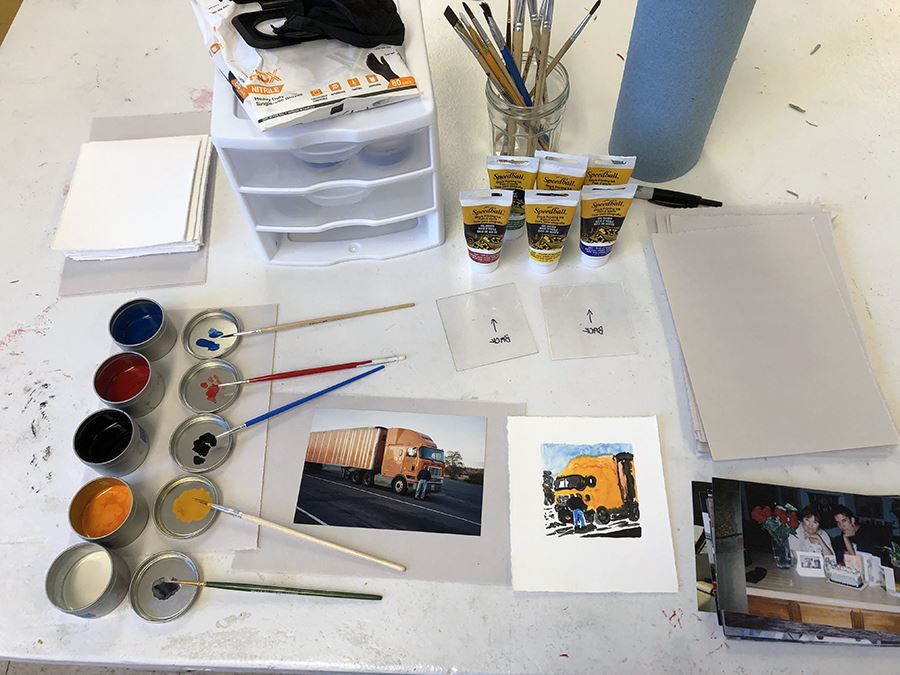One of my favorite questions to ask artists is: if there was an apocalypse and you were the only person left but all of your basic needs were met (electricity still works, you have plenty of food, etc.) would you continue to make art?
In my Considering Everything article, I discussed idea generation and where to start when you are beginning a project. But after you have your idea there are still a lot of decisions to make and all of the effort that goes into the creation of your work. The art-making process can be draining and it seems inevitable for artists to experience maker’s block at some point, so how do you keep your momentum and motivation as an artist? How do you stay interested in what you are making over the course of your artistic life? What do you do if you get stuck along the way? I do not believe there is a universal answer, so I would like to present some solutions and encourage a discussion about additional solutions.

Monotype by Beth Sheehan
Sometimes artists get stuck at the idea generation stage. When this is the case for me, I find that there are two primary causes. First, my output can only be as good as my input: similar to the way gas tanks function, if I have not filled my tank, my creative practice will run out of momentum. So, if I am not having success generating ideas and artwork, I consider what I have been reading, watching, listening to, and looking at. Inspiration can come from anywhere, but it has helped me to recognize what kinds of sources provide me with inspiration more frequently than others and then turn to those kinds of sources again and again.
The second cause that typically blocks my idea generation is often a processing issue. I may have many ideas and a lot of creative fuel, but if I do not spend time processing and organizing my thoughts, the fuel is not usable. To assist in my processing, I prefer to journal about my ideas. I usually ask myself questions such as:
● What interests me most about this idea?
● What part of my idea feels the least solid?
● What are the most important aspects of this idea?
● Should this idea become several separate projects?
● Are there any rules that I would like to impose on this idea (such as a specific size, form, medium, etc.)?

Beth Sheehan graining a litho stone
Sometimes artists get stuck at the execution stage. Perhaps you enjoy coming up with ideas but do not enjoy the actual making. There is precedent for creating non-object artworks, one form being what Gao Minglu terms “proposal art (fangan yishu)”[1]. However, there are also ways to push forward into actually making your work, as well. It should be noted first, though, that art does not have to be made within a specific timeframe, you are allowed to work on more than one artwork at a time, and you are not a failure if you abandon a project that is no longer enjoyable (it is good to remember that just because you have spent time, money or energy on a project, does not mean you need to continue with it, as per the Sunk Cost Fallacy).
During the execution stage, I find that it is easier to move forward if I produce test prints, material tests, or make multiple mock-ups of my ideas. Alternatively, I occasionally find it more beneficial to make smaller projects that I do not treat seriously. By focusing on something that is lower stakes and more immediate like a quick one-page book, a collage, or a monotype print, I can get into the mode of making without the pressure of executing my actual project. Using writing prompts as making prompts or using ideation decks can be particularly liberating.
And finally, if I am further along in the execution stage and feel myself losing momentum, I find it best to invite an artist, art historian, critic, or curator to my studio for a studio visit. The visitor might see threads in your work that you have not seen, they may suggest artists or media for you to research that help reinvigorate your passion for your project, or you may even disagree with their insights but through disagreeing, you find you are able to think through what you think about your work in ways you were unable to do alone.
[1] Gao Minglu, Total Modernity and the Avant-Garde in Twentieth-Century Chinese Art (Cambridge: The MIT Press, 2011), page 142.
Beth Sheehan is an artist currently living in Tuscaloosa, AL. She teaches paper, print, and book workshops around the US and virtually. She co-authored the book Bookforms. Sheehan has also worked as a professional printer at Durham Press and Harlan & Weaver and was the Bindery Manager at Small Editions.

